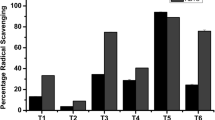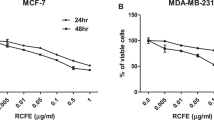Abstract
There is tremendous scope for identifying novel anti-cancer molecules from the unexplored reserves of plant kingdom. The application of dietary supplementation or medicine derived from such sources is a promising approach towards treatment of cancer. In the present study we have evaluated the antiproliferative potential of 4-hydroxyisophthalic acid (4-HIPA), which is a novel antioxidant compound isolated from the roots of the aqueous extract of Decalepis hamiltonii. 4-HIPA was screened in vitro against human breast cancer cell lines MCF-7, MDA-MB-468 and normal human breast epithelial cell MCF-10, and demonstrated that human breast cancer cell lines, in contrast to MCF-10, are sensitive to 4-HIPA .4-HIPA showed marked reduction in cell viability and short-term proliferation assays in these cells. Results of the long-term colony formation and scratch assay further reaffirmed that 4-HIPA inhibited the growth and proliferation in breast cancer cells. We further conducted in vivo studies using murine Ehrlich Ascites Tumor (EAT) cell model. Our in vivo results established that treatment with 4-HIPA reduced the tumorigenesis by promoting apoptosis in EAT-bearing mice. The results of our molecular docking predictions further warranted our claim. This study is valuable as 4-HIPA exhibits antiproliferative potential that can be exploited in the development of anticancer drugs.








Similar content being viewed by others
Abbreviations
- 4-HIPA:
-
4-Hydroxyisophthalic acid
- CP:
-
Cyclophosphamide
- EAT:
-
Ehrlich ascites tumor cells
- LDH:
-
Lactate dehydrogenase
- ALT:
-
Alanine transaminases
- AST:
-
Aspartate transaminases
- ALP:
-
Alkaline phosphatase
- MST:
-
Mean survival time
References
Wong MC et al (2016) Global Incidence and mortality for prostate cancer: analysis of temporal patterns and trends in 36 countries. Eur Urol 70(5):862–874
Zarei M, Shivanandappa T (2016) Neuroprotective effect of Decalepis hamiltonii on cyclophosphamide-induced oxidative stress in the mouse brain. J Basic Clin Physiol Pharmacol 27(4):341–348
Harish R et al (2005) Isolation of antioxidant compounds from the methanolic extract of the roots of Decalepis hamiltonii (Wight and Arn). J Agric Food Chem 53(20):7709–7714
Zarei M, Shivanandappa T (2013) Amelioration of cyclophosphamide-induced hepatotoxicity by the root extract of Decalepis hamiltonii in mice. Food Chem Toxicol 57:179–184
Srivastava A, Shivanandappa T (2006) Hepatoprotective effect of the aqueous extract of the roots of Decalepis hamiltonii against ethanol-induced oxidative stress in rats. Hepatol Res 35(4):267–275
Srivastava A, Rao LJM, Shivanandappa T (2012) A novel cytoprotective antioxidant: 4-Hydroxyisophthalic acid. Food Chem 132(4):1959–1965
Subhashree AR et al (2012) The reference intervals for the haematological parameters in healthy adult population of chennai, southern India. J Clin Diagn Res 6(10):1675–1680
Kornberg A, Lieberman I, Simms ES (1955) Enzymatic synthesis of purine nucleotides. J Biol Chem 215(1):417–427
Lala V, Minter DA. (2019). Liver function tests, in StatPearls, StatPearls Publishing StatPearls Publishing LLC.: Treasure Island (FL)
Lala V, Minter DA. (2019). Acute cystitis, in StatPearls, StatPearls Publishing StatPearls Publishing LLC.: Treasure Island (FL)
Ali SJ et al (2019) Bone loss in MPTP mouse model of Parkinson's disease is triggered by decreased osteoblastogenesis and increased osteoclastogenesis. Neurotox Res 363:154–163
Ali SJ, et al. (2019). Chlorpyrifos exposure induces parkinsonian symptoms and associated bone loss in adult swiss albino mice
Payne J et al (2000) Improving the reproducibility of the MCF-7 cell proliferation assay for the detection of xenoestrogens. Sci Total Environ 248(1):51–62
Franken NA et al (2006) Clonogenic assay of cells in vitro. Nat Protoc 1(5):2315–2319
Liang CC, Park AY, Guan JL (2007) In vitro scratch assay: a convenient and inexpensive method for analysis of cell migration in vitro. Nat Protoc 2(2):329–333
Rates SM (2001) Plants as source of drugs. Toxicon 39(5):603–613
Ramnath V, Kuttan G, Kuttan R (2002) Antitumour effect of abrin on transplanted tumours in mice. Indian J Physiol Pharmacol 46(1):69–77
Zarei M et al (2013) Cardioprotective effect of the root extract of Hemidesmus indicus against doxorubicin-induced oxidative stress in mice. Pharm Lett 5(1):334–339
Atanasov AG et al (2015) Discovery and resupply of pharmacologically active plant-derived natural products: a review. Biotechnol Adv 33(8):1582–1614
Harish R, Shivanandappa T (2010) Hepatoprotective potential of Decalepis hamiltonii (Wight and Arn) against carbon tetrachloride-induced hepatic damage in rats. J Pharm Bioallied Sci 2(4):341–345
Kogo M et al (2011) Analysis of the risk factors for myelosuppression after chemoradiotherapy involving 5-fluorouracil and platinum for patients with esophageal cancer. Hepatogastroenterology 58(107–108):802–808
Contreras-Zentella ML, Hernandez-Munoz R (2016) Is Liver enzyme release really associated with cell necrosis induced by oxidant stress? Oxid Med Cell Longev 2016:3529149
Srivastava JK, Gupta S (2006) Tocotrienol-rich fraction of palm oil induces cell cycle arrest and apoptosis selectively in human prostate cancer cells. Biochem Biophys Res Commun 346(2):447–453
Stefanini M (1985) Enzymes, isozymes, and enzyme variants in the diagnosis of cancer. A short review. Cancer 55(9):1931–1936
Xia M et al (2004) Dracorhodin perchlorate induces apoptosis via activation of caspases and generation of reactive oxygen species. J Pharmacol Sci 95(2):273–283
Acknowledgements
The correspondent author wishes to thank Prof. Cletus D'Souza, the Head of the Department of Biochemistry, University of Mysore, for his support and guidance at the time of this study.
Author information
Authors and Affiliations
Corresponding authors
Ethics declarations
Conflict of interest
The authors have no conflicts of interest to disclose.
Additional information
Publisher's Note
Springer Nature remains neutral with regard to jurisdictional claims in published maps and institutional affiliations.
Rights and permissions
About this article
Cite this article
Zarei, M., Shivanandappa, T. & Zarei, M. Natural bioactive 4-Hydroxyisophthalic acid (4-HIPA) exhibited antiproliferative potential by upregulating apoptotic markers in in vitro and in vivo cancer models. Mol Biol Rep 47, 5343–5353 (2020). https://doi.org/10.1007/s11033-020-05617-x
Received:
Accepted:
Published:
Issue Date:
DOI: https://doi.org/10.1007/s11033-020-05617-x




